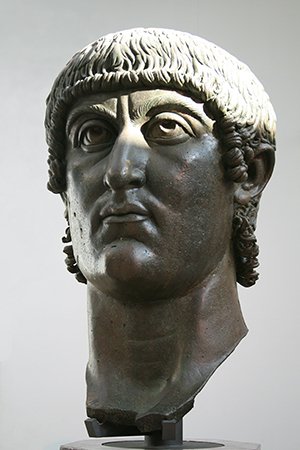Mussolini and the Italian fascists used Latin – the language of powerful men like Caesar and Augustus — to portray themselves as the rightful heirs of the Roman Empire.
On 9 May 1936, Italian Fascist leader Benito Mussolini held one of his most famous speeches. Italy had triumphed in the second Italo-Abyssinian War; the King of Italy was now also the ruler of the empire, which included modern-day Ethiopia and Eritrea.
From the balcony on the second floor of Palazzo Venezia in Rome, Mussolini proclaimed the restoration of an Italian empire before an ecstatic crowd. The imperial proclamation opened with the words:
"Italy finally has its empire. It is a fascist empire, an empire of peace, an empire of civilisation and humanity."
Two weeks later, the proclamation was published in Latin translation in a magazine, and later also in book form. The translation was done by a professor named Nicola Festa, and Mussolini was quite pleased with his work.
Why was the Italian Fascist leader so intent on being translated into the language of antiquity?
"I can understand that it may seem strange at first glance. When it comes to translation and classical languages, we are used to a path that runs from the past to the present; from 'dead' languages to modern, living languages. That fascists did the opposite; translating from Italian into Latin was rooted in a desire to anchor their ideology in what they believed to be ancient Roman traditions," says Han Lamers.
The Dutchman is Associate Professor at the Department of Philosophy, Classics, and the History of Art and Ideas at the University of Oslo. In recent years, he and Bettina Reitz-Joosse from the University of Groningen have done considerable research on how the Italian Fascist regime (1922-1943) used Latin for political purposes.
"Both voice and echo"
"The fascists saw themselves as the restorers and rebuilders of the Roman Empire. They worshipped ancient Rome and everything that could be linked to mighty leaders like Caesar and Augustus," Lamers says.

Among other things, the fascists introduced the so-called Roman salute with outstretched right arm. In their view, the habitual handshake greeting was both weak and unhygienic. They diligently used an ancient symbol of power, the fasces ("fascism" is a derivation of this word): a bundle of wooden rods that was carried during processions and ceremonies in the Roman Empire.
And they revitalised the Latin language.
«Latin had been a world language, and even though Latin more or less died out as an international language during the period from 1650 to 1800, Italia still had a rather strong tradition of writing in Latin. The church used Latin, and some poets wrote in Latin. As such, the language was not dead, but what the fascists did was give Latin a new meaning,» Lamers explains.
The fascists used Latin to intensify their cult of reverence for the Roman Empire and ancient Roman virtues such as courage, vigour and stamina. Latin assumed a dual role; it both linked fascism with a proud tradition and communicated an ideology fascists believed was revolutionary and forward-looking.
"The poet Alfredo Bartoli, who wrote in Latin, believed that, in 1934, the Latin language belonged both to the past and to the present, giving the revolutionary spirit of the age a classical form; the language was 'voice and echo at the same time'," the researcher says.
National treasure
The fascists promoted Latin as a national language of which all Italians should be proud. Latin was taught in school and at least one textbook on modern Italian history was written in Latin.
"Not learning Latin was seen as a form of desertion – albeit mild – from the ideals of the regime. Latin was not meant to replace Italian, but was viewed as a language that was particularly well-suited to bearing the essence of fascism," Lamers says.
Latin texts received an enthusiastic reception in a circle of leading intellectuals, but so far, researchers do not know very much about its reception among the general public – or to what extent Latin textbooks were used in the schools.
"What was probably the most visible to ordinary people was the many Latin inscriptions displayed across Rome's urban landscape," says the UiO researcher.

The heart and brain behind the work of revitalising Latin rested with the Institute of Roman Studies (Istituto di Studi Romani) in "The Eternal City". The Institute appointed committees to renew the language, established a translation office, created technical terms so that Latin could be used in modern science – and was engaged in giving lectures and other public education activities about ancient Rome and its language.
"They had to update the language and create new words to cover new topics and new ideals," says Lamers.
The Italian fascists eventually also developed an ambition to internationalise the Latin language – to make it a lingua franca in the world.
"They had the idea that when you translate from Italian to other languages, the result was somehow inferior to the original text. If you could communicate with the world in Latin – which had once been a world language – this degradation could be avoided. Latin was also seen as particularly suited to communicating fascist ideals and ideas," explains Lamers.
Fascist greeting to future generations
In 1932, in conjunction with the 10-year anniversary of Mussolini's takeover of Italy, the fascists erected an obelisk at the sports complex which today houses the home stadium of the Lazio and Roma football teams.
The obelisk is visually spectacular, but the most interesting aspect of the memorial is not visible to the naked eye. Underneath tonnes of marble lies a box with some medals and a text written on parchment.
The text – which is in Latin – was also published in slightly different variations in different publications. Lamers and Reitz-Joosse have co-authored the book "Codex fori Mussolini", in which the text is reconstructed, translated into English and annotated.
"The text consists of three parts. The first is about how Mussolini saved Italy after the First World War," says Lamers, quoting a fairly typical sample:
«At this time by some divine command and will, a MAN appeared. He was gifted with a singular sharpness of mind and a most steadfast spirit and ready to undertake or to undergo anything bravely. In his divine mind, he formed the plan not only to restore the fallen and overthrown fortunes [of Italy] to their former state, but even to restore to the Italians that Italy which the ancient Romans had turned into a light for the entire world, and he set about making his deeds equal to his plans. This man was BENITO MUSSOLINI."»
"The second part was a presentation of the Fascist Youth Organisation and its leader. This was an important organisation that was tasked with shaping new people according to Roman ideals as the fascists saw them; people who could act and suffer with great courage," says Lamers.
The third part was an evocation of how the obelisk was transported to the city from marble quarries in Carrara and erected – in almost supernatural fashion – in Rome.

"Time capsule"
Lamers and Reitz-Joosse believe the box under the obelisk was intended to be a type of time capsule and that the Latin text was meant for an audience in the future.
"The fact that the text was written on parchment – which is more durable than paper – is an indication of this. The fact that they pedagogically explained what the First World War was, also indicates that they envisioned readers far into the future," says Lamers.
But would it not have been more natural to choose a living world language such as English to communicate with people in the future?
"From the fascist's viewpoint, Latin was probably a rational choice. They looked at Latin as a language for the future, and we should also remember that it was not regarded as a 'dead' language. It was still used by the Church, poets wrote in Latin, and it had all in all proved to be a durable, transhistorical language," the researcher says.
The text underneath the obelisk has been portrayed in the media as "Mussolini's letter to the future", but Lamers is uncertain about just how involved Mussolini was in this particular project:
"There are many indications that it was primarily the leader of the Fascist Youth Organisation, Renato Ricci, who was behind it. The sources that might give us an answer to this question have so far not been made available to us."
Philologists and fascism
Those who research classical literature and classical languages – philologists – saw renewed interest in their field of study when the fascists came to power. The attention brought with it both greater prestige and ethical challenges.
"Some of those who experienced that fascism gave them renewed professional credibility, let themselves be used by the regime. They placed their specialised knowledge at the disposal of Mussolini's regime and helped shape the propaganda and ideology that supported it. This is what we might call the 'dark side' of classical philology. It happened both in Mussolini's Italy and in Hitler's Germany, which was preoccupied with ancient Greece and especially Sparta," Lamers says.
He nevertheless emphasises that how the philologists viewed the regime was very individual. Some were adversaries, others embraced fascism and many worked in less politicised branches of the field.

Emperor Constantine and the Church
It is well known that the fascists worshipped Caesar and Augustus, who are generally regarded as the "greatest" Roman leaders. It is less known that the fascists also took great interest in Constantine the Great, who was emperor from 306-337.
"Constantine is usually considered the first Christian emperor, and some fascists at least saw it was opportune to align themselves with a Christian tradition," says Lamers.
Mussolini did not always have a good relationship with the Vatican, but the situation improved after the Lateran Treaty in 1929, which led to the creation of the Vatican City state with the Pope as monarch. Afterwards, Mussolini was occasionally compared with Constantine the Great, who through the 313 Edict of Milan promised freedom of religion in the Roman Empire.
"This comparison was useful for Mussolini, who needed support from the Catholic establishment," says Lamers, adding that a PhD student is now in the process of exploring how the Church viewed fascism's fierce flirtation with Latin:
"The Catholic Church had never stopped using Latin, so I think it would be very interesting to see how they reacted to the fascists' appropriation of Latin as 'their language'. Did they resist, or play along?"
Trumpet fanfare in a landscapes of ruins
We all know how it went with Mussolini and his dream of a new Roman Empire. On 28 April 1945, the leader himself, his mistress Clara, and several members of his fascist government were executed by communist partisans.
The imperial proclamation of Nicola Festa had lost its lustre when the regime collapsed. Lamers says that towards the end of the war, the historian Salvatore D'Elia was isolated in a small town where the schools were closed and the power was shut off. There he sat, realising that Festa's Latin – which he thought, despite all, was elegant – was "a meaningless trumpet fanfare in a landscape of ruins".
References
Han Lamers (2017): "Latinizing Mussolini's Message: Nicola Festa's Latin Translation of the 'Proclamation of Empire' (1936/7)", International Journal of the Classical Tradition, Vol. 24. Iss. 2. pp. 198-218.
Han Lamers and Bettina Reitz-Joosse (2016): "Lingua Lictoria: the Latin Literature of Italian Fascism", Classical Receptions Journal, Vol. 8 Iss. 2 pp. 216-252.
Han Lamers and Bettina Reitz-Joosse (2016): "The Codex fori Mussolini: A Latin Text of Italian Fascism".
Rannem, Øyvin (2017): "Capitalis i fascismens tegn" in the book Bokstavene i historien. Maktsymbol fra Augustus til Mussolini. pp. 330–357.
Anchoring fascism
The research discussed in the article is part of the "Anchoring Fascism" project, a collaboration between the University of Oslo and the University of Groningen in the Netherlands and part of a larger research programme that looks at how innovations are anchored in traditions (e.g. when e-books mimic the page division from a physical book to seem "book-like"). Han Lamers and Bettina Reitz-Joosse have especially looked at how the Italian fascists in the period 1922-1943 used the Latin language to anchor their revolution in a greater historical tradition. With funding from UiO, the researchers will eventually digitise a collection of Latin texts and translations published by the fascists. See also: https://anchoring-fascism.com/
See also:
Both Mussolini’s and Hitler’s rise to power followed the rules of democracy
Many Russians hoped that Hitler would free them from Stalin
Farmers’ youth were to “Norwegianise” Oslo through folk dance and theatre



